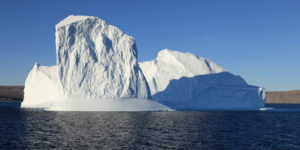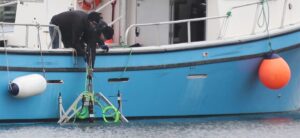Written by Rose Fisher
On the East Coast of Canada, nestled between Nova Scotia and New Brunswick, is one of the most unique ocean environments in North America, The Bay of Fundy. While it’s famous for having the highest tides in the world, there is much more to this charismatic environment than just its rapidly rising and falling waters. The Bay of Fundy is a highly productive ecosystem, rich in biological diversity. It’s a hot spot for a number of whale species including humpback and fin whales, as well as porpoises, seals, and many species of fish, sea birds and crustaceans. The area is also home to the Port of Saint John, one of Canadas busiest ports. Eastern Charlotte Waterways, a not-for-profit located in Blacks Harbour, saw a critical gap in knowledge of the area, and through strategic smart hydrophone deployments, have started to piece together an acoustic mosaic of this rich ocean environment.
In 2015, an underwater noise monitoring project was created to monitor noise levels in the Bay of Fundy, around the Port of Saint John. Noise monitoring can provide a baseline sound profile and data on how an area changes acoustically over time. Port of Saint John is a busy port, with the number of vessels visiting the area growing year over year. It has become the third largest port in Canada by tonnage and the fourth most popular cruise destination. By working with Eastern Charlotte Waterways, the port is doing its best to not only understand its impact on the environment but using this knowledge to better protect the area and mitigate the effects of increased, but essential industry.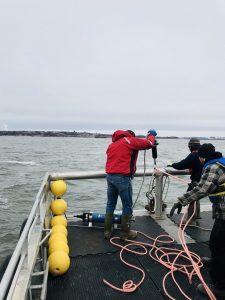
Acoustic data was collected by hydrophones at multiple sites deployed outside of the harbour over three years, from 2015-2017, creating a long-term acoustic profile of the area. The ambient noise measurements of the areas were compared over time. The first deployment, in June 2015, saw an Ocean Sonics icListen hydrophone deployed just outside Dipper Harbour, NB, close to Saint John Harbour and its busy shipping lanes.
In 2016, Eastern Charlotte Waterways continued their acoustic monitoring of the Bay of Fundy, this time deploying the icListen hydrophone southwest of Partridge Island, NB. The location was chosen for its proximity to the Port of Saint John. The island, located at the mouth of the port, would allow Eastern Charlotte Waterways to deploy the hydrophone in an area where it could easily detect marine wildlife, while also collecting data on vessel traffic and ship noise, as vessels entered and exited the port.
The 2016-2017 deployments consisted of 5 strategic installations of Ocean Sonics icListen hydrophones to collect data over the course of a year. Each hydrophone was connected to an Ocean Sonics battery pack and mounted on a metal cone to keep them off the seabed. The system was anchored to the seabed with a high-flyer buoy for easy retrieval. The hydrophones were set up to record the first 2 minutes of acoustic data every 10 minutes, this allowed the battery packs to supply power to the hydrophones for 2-3 months.
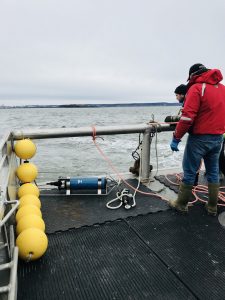
Eastern Charlotte Waterways multi-year noise monitoring project had two goals. One, to detect marine wildlife in the area, and two, to monitor vessel traffic and subsequent noise levels. Marine mammals rely on sound for many of their basic needs including finding food, avoiding predators, mating and rearing young. Vessel traffic introduces noise into the marine environment, so it is essential that the amount of noise and its effects on the environment are understood. Port of Saint John has taken a proactive approach to noise mitigation.
Many marine mammals were detected in the data throughout the deployments, the most common being dolphins, identified by their distinct clicks, buzzes and whistles. Year-round inhabitants of the area, harbour seals, were also detected frequently throughout the data set. In the 2015 recordings there were many vocalizations from a number of different marine species including dolphins, harbour porpoises and seals. Many migratory species were detected including endangered North Atlantic Right whales and Sei whales, as well as Humpback whales and possible Blue whales. The 2016-2017 data confirmed the diverse nature of the area, with many of the vocalizing animals returning to the region. Humpbacks visited the area in November and December of 2016, and then returned again in September and October of 2017. Low frequency baleen whale calls were recorded by the hydrophone, including Blue whales and Fin whales. And in the fall of 2016, potential calls from the endangered Sei whale were again detected.
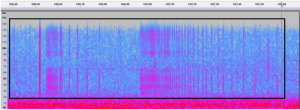
Spectrogram showing porpoise clicks
While the abundance of marine mammal vocalizations is fantastic to hear, it’s important to note that in nearly all of the recorded data, vessel noise was present. Noise came from a variety of sources such as ships entering and exiting the port, the nearby ferry, and distant vessels in the area. Larger vessels tend to increase noise levels for longer periods of time as the low frequency noises travel further through the water. Smaller vessels increase noise in higher frequencies, but attenuation of these frequencies only allows the noise to travel short distances. The smaller vessels such as pilot vessels and ferries increase sound levels in higher frequencies from smaller propellers and increased speeds. The noise from these vessels attenuate much faster and do not affect low frequency communication in baleen whales but can still have an impact on mid and high frequency communication from whales and dolphins as well as many marine organisms close to the vessel.
Because the ferry spends a lot of time in the area, there are increased noise levels in higher frequencies for longer periods of time and this affects marine organisms in the area. Further studies covering frequencies up to 200 kHz are needed to acquire full noise profiles of vessels which can then be used to assess the impact on marine mammals such as dolphins and harbour porpoise.
There is growing concern around the world about the effect of noise on aquatic life. Performing baseline studies like the one performed by Eastern Charlotte Waterways creates a snapshot of the ocean environment, allowing researchers and industry alike to monitor and mitigate the amount of noise introduced into an environment. Standards such as the European Marine Strategic Framework Directive, are leading the way for responsible exploration and development of our aquatic industries, while ensuring the protection and prosperity of essential ocean ecosystems.
Industry and environment can co-exist. Understanding the effect of anthropogenic noise in marine environments is the first step in creating a mutually beneficial system that allows the two to exist in harmony. The data collected by Eastern Charlotte Waterways between 2015 and 2017 clearly demonstrates the need for acoustic monitoring of the area, as numerous species of pinnipeds, cetaceans, fish and crustaceans inhabit or migrate in and out of the area every year. By taking proactive measures, the Port of Saint John has emerged as a leader in good environmental practice while maintaining thriving shipping and cruise industries.
*Featured in ECO magazine Special Edition on Sound (July, 2019) Click Here for full publication
**Photos provided by Eastern Charlotte Waterways
